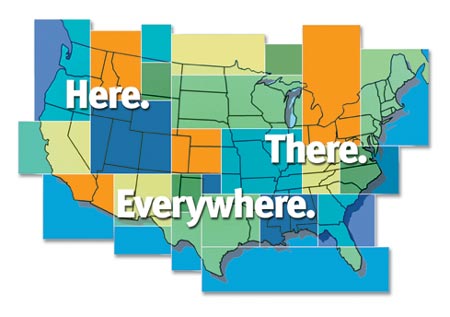Millennials are driving today’s transformation of major urban centers, according to a fall 2014 Cushman & Wakefield report. Many are opting to ditch cars as long as they can live within walking distance of amenity-rich areas and easily catch transit when they’re looking to venture beyond their neighborhood hub. In just six years, C&W reports, they’ll make up more than half of the global workforce. This expanding cohort of workers born since 1982 is likely to turbocharge another phenomenon with important ramifications for commercial practitioners: the demand for so-called transit-oriented development.
These mixed-use areas in cities and suburbs are located a half-mile or less from public transportation and typically occur in higher-density communities. Along with improving access to jobs, such developments spur other benefits, including reductions in driving rates, road congestion, and greenhouse gas emissions. Perhaps the most radical departure of all from conventional development priorities, onsite parking is typically a minimal or nonexistent part of the plan.
However, like the millennials themselves, TODs have matured since they first emerged. In some cases, neighborhood activists are pushing for TODs. And where they’re not on consumers’ radar, developers are fine-tuning their strategies to seek meaningful community involvement. Smart developers understand they need to offer more than just proximity to transit. Their projects need to reflect the changing lifestyles of younger consumers who are more likely to be tethered to their electronic gadgets than to a vehicle—a reality that lenders are starting to grasp as well.
Since the late 1990s, TOD has been a force in the development world, says David Dixon, an urban planner at Stantec in Boston. The Great Recession, however, changed TOD’s trajectory.
“Transit’s ability to really incent development—and a different kind of development, of walkable communities—first became recognized in the late 1990s and early 2000s,” he explains. “But coming out of the recession there’s been so much more awareness of the power of cities to attract people, the interest in walkable environments, and the desire to not have a car. ”
Data has begun emerging showing that TOD improves property values. A 2009 study by CEOs for Cities found that in 13 of the 15 markets analyzed, increased walkability in a neighborhood was directly linked to higher home values.
Fitzhugh Stout, senior managing director of the Charlotte, N.C., office of Integra Realty Resources, a real estate valuation company, studied the effect of a light rail line that opened in his area in 2007. He found properties had increased in value from 5 percent to 73 percent since then, and the most dramatic increases came from changes in zoning that permitted increased density. “Everywhere in the country, people talk about reducing parking and getting higher density in development,” he says. “Transit has allowed that to happen.”
Another factor critical to TOD’s growth is Americans’ ever-increasing focus on health. About 15 years ago, recalls Dixon, Dr. Richard Jackson, then director of the Centers for Disease Control’s National Center for Environmental Health, started talking about a link between auto dependence and obesity. Today people consider a walkable environment a healthier environment. That’s a sea change, says Dixon, from when people saw the lawns of the suburbs and thought they translated to a healthier life.
Community Pushes for TOD
It was local residents who clamored for a high-density development at 1611 W. Division in Chicago. The city passed an ordinance in September 2013 permitting higher density and less parking for developments near transit hubs. The 99-unit apartment building sits atop the city’s Blue Line “el” train stop at Division, an intersection six bus lines traverse daily.
The project’s specs were heavily shaped by a local community group. “It wasn’t the developer saying, ‘We want to build a TOD project,’ ” says Jamie McNally, an architect and project manager for the project’s developer, Rob Buono. “A community group had a master plan before this project was created. [It] wanted moderate to high density [and] low parking, and the idea was to promote pedestrian-friendly, walkable neighborhoods.”
There’s no on-site or even authorized street parking for residents. Leases even prohibit residents from getting street-parking passes from the city. That hasn’t been a deterrent in leasing. Units were fully leased when the property opened in October 2013.
They range from 507-square-foot studios to 1,146-square-foot two-bedroom two-bath apartments with rents ranging from $1,495 to $3,450 per month. The property includes a free second-floor bike garage and a “train tracker” screen in the lobby so residents can see where transit vehicles are in real time. Across the street is a station for Divvy, the city’s bike--sharing program launched in June 2013.
The property has 5,000 square feet of commercial space and about 7,050 square feet of ground-floor retail space. McNally says despite its growing popularity, TOD doesn’t automatically translate to a higher return for developers. “It depends on the individual project,” says McNally. “There are so many factors in new construction.” While some lenders have reservations about financing projects without parking, it wasn’t the case with this project, and that’s changing overall. “It’s partly because there’s been a paradigm shift in urban planning and lifestyles. Young professionals don’t necessarily want or need a car and all the expenses that go along with it,” he says.
Hotel? What a Great Idea!
Community input has also been critical to a $100 million TOD in Huntington, N.Y., on Long Island, currently in the permitting and environmental review stage, by Renaissance Downtowns, a developer based in nearby Plainview, N.Y. In the works is a 170-room hotel set to open in spring 2017. It’ll be supplemented with a 100,000-square-foot office building; two mixed-use buildings, one with retail on the ground level plus two stories above it featuring 70 residential units; and a 48-unit artists’ live-work building.
All those buildings will sit within a half-mile of the Huntington Station rail stop, which lands riders in Manhattan in about an hour, taking the place of commuter parking lots that currently exist. “Our whole model is going to municipalities near train stations with a lot of surface parking that’s underutilized and replacing the parking with new buildings that include parking within the structures,” says Sean McLean, the company’s vice president of planning and development.
The project is being financed privately through RXR Realty, says McLean. RXR, which operates in New York, New Jersey, and Connecticut, launched an “emerging markets fund” to focus on rebuilding downtowns in the area using input solicited from community members.
To recruit local involvement, Renaissance Downtowns relies on “crowdsourced placemaking.” The company opens an office in the development zone and staffs it with local residents, explains McLean. Those staffers hold daily community meetings and office hours. The company also launched a website,
Source the Station, to provide information to residents.
In fact, the hotel at Huntington Station wasn’t even on Renaissance’s radar. But the community spoke and Renaissance’s market analysis confirmed the area was ripe for a hotel.
“The challenge for us is always gaining the trust of the community and gaining their activity,” says McLean. “We concentrate on activating the silent majority to make sure they’re at the table rather than just the 10 squeaky wheels. Then we get the majority what they’re looking for in their community.”
When it comes to calculating the return on investment on TOD in the Northeast, McLean says it’s directly related to the distance from the development to the nearest major metro area. The closer the TOD project to Manhattan, for example, the better the return.
Like McNally, McLean says parking remains a challenge when it comes to financing TOD projects, as some lenders remain skeptical about the viability of projects that deemphasize parking. “Lenders are still looking for one to one-and-one-third spaces per unit.”
Long-Range Planning Pays
It’s taken 10 years, but sales will begin this April for the TOD at the Washington, D.C., Metro’s Shady Grove stop in Montgomery County, Md., reports A.J. Jackson, managing partner at EYA, a TOD--focused developer based in Bethesda, Md. Residents are expected to start moving in by year’s end. The project, which is also adjacent to the Shady Grove station for MARC, Maryland’s commuter rail system, will include 1,100 one- and two-bedroom apartments, 400 townhomes, 15,000 square feet of retail, and 130,000 square feet of commercial space all within steps of the station.
What took so long? EYA purchased land a dozen years ago near—but not next to—the Metro station. It then decided its project would be more successful for both it and the community if it were located adjacent to the station on property then owned by the county. It took all that time for EYA to convince county officials to buy EYA’s land and sell EYA the land next to the Metro station. That required relocating all the operations that existed on the county’s property, which included a transit bus depot and a massive kitchen where public school lunches were prepared. In exchange, EYA agreed to shepherd both properties through the required zoning and approval processes so it and the county ended up with -development-ready land.
Fifteen percent of the project will include moderate-income housing (for those who earn 60 percent or below of the area’s median income) and another 10 percent will be workforce housing (for those who earn 80 to 115 percent of the area’s median income), says Jackson. Rentals are expected to draw from $1,100 to $2,600 per month. Townhomes will likely range from $185,000 to $400,000 for the moderate-income and workforce housing, while market-rate units will range from $650,000 to $800,000.
EYA is financing the $550 million project with traditional debt and equity. It’s relying on funding from institutional investors for the townhomes and condos, in addition to loans from commercial banks.
“When it comes to developments with units for sale, rather than leasing, demand and values have remained strong for infill in general, so lenders have been aggressive in seeking our business, Jackson says. “On the other hand, financing for multifamily rental has been tighter because there’s a lot of supply.”
Because infill projects are generally riskier and more time consuming than other projects, Jackson says, developers tend to focus on projects with an ROI that justifies the extra effort. “There’s a lot of up-front risk in these projects, and those cost are typically funded from equity.”
Jackson agrees with colleagues that planning for parking can be tricky. At Shady Grove, townhomes have attached parking for one or two cars while rentals have fewer allotted parking spaces. “One consideration is who’s moving into the units. You may be doing larger units targeted for empty nesters. They may be less willing to give up their cars,” he says. You also have to think about what amenities are within walking distance. The higher the Walk Score, the less parking you need.
Bottom line: You can’t just throw up a development near a subway station and call it a day. Transportation (and not necessarily rail; good bus service also qualifies), walkability, and neighborhood amenities are all factors in successful TOD, he says. “It’s a dynamic analysis.”
 PRINT |
PRINT |  EMAIL
EMAIL







